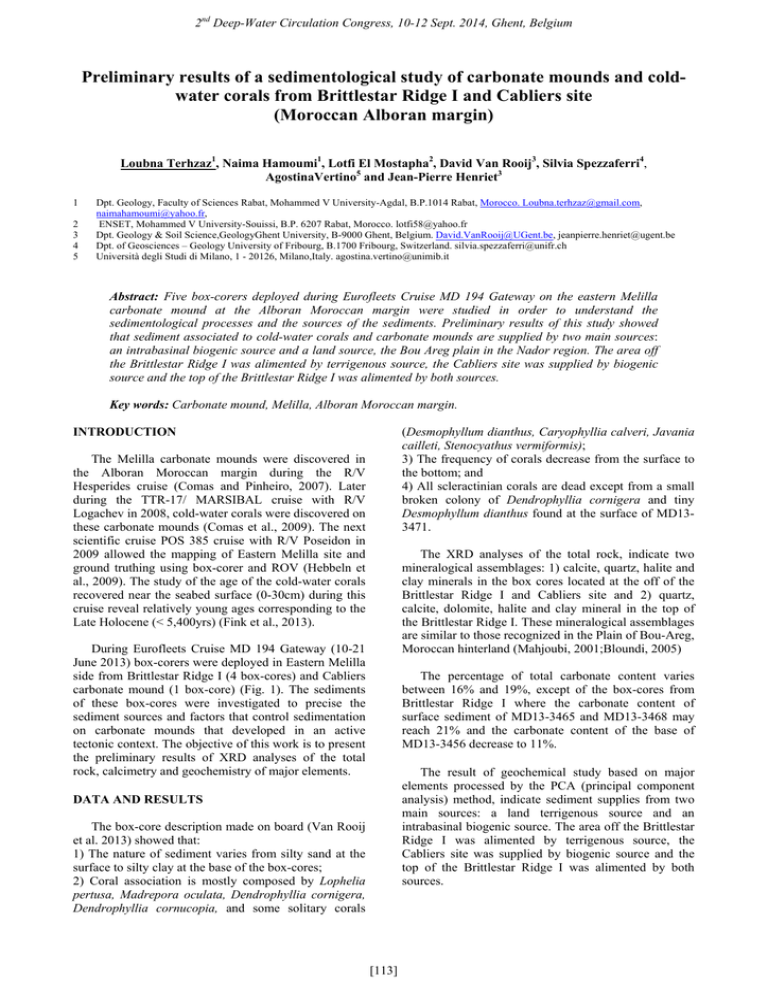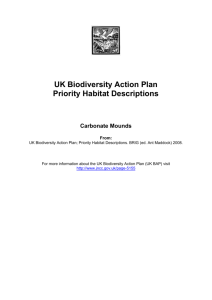Preliminary results of a sedimentological study of carbonate mounds and... water corals from Brittlestar Ridge I and Cabliers site
advertisement

2nd Deep-Water Circulation Congress, 10-12 Sept. 2014, Ghent, Belgium Preliminary results of a sedimentological study of carbonate mounds and coldwater corals from Brittlestar Ridge I and Cabliers site (Moroccan Alboran margin) Loubna Terhzaz1, Naima Hamoumi1, Lotfi El Mostapha2, David Van Rooij3, Silvia Spezzaferri4, AgostinaVertino5 and Jean-Pierre Henriet3 1 2 3 4 5 Dpt. Geology, Faculty of Sciences Rabat, Mohammed V University-Agdal, B.P.1014 Rabat, Morocco. Loubna.terhzaz@gmail.com, naimahamoumi@yahoo.fr, ENSET, Mohammed V University-Souissi, B.P. 6207 Rabat, Morocco. lotfi58@yahoo.fr Dpt. Geology & Soil Science,GeologyGhent University, B-9000 Ghent, Belgium. David.VanRooij@UGent.be, jeanpierre.henriet@ugent.be Dpt. of Geosciences – Geology University of Fribourg, B.1700 Fribourg, Switzerland. silvia.spezzaferri@unifr.ch Università degli Studi di Milano, 1 - 20126, Milano,Italy. agostina.vertino@unimib.it Abstract: Five box-corers deployed during Eurofleets Cruise MD 194 Gateway on the eastern Melilla carbonate mound at the Alboran Moroccan margin were studied in order to understand the sedimentological processes and the sources of the sediments. Preliminary results of this study showed that sediment associated to cold-water corals and carbonate mounds are supplied by two main sources: an intrabasinal biogenic source and a land source, the Bou Areg plain in the Nador region. The area off the Brittlestar Ridge I was alimented by terrigenous source, the Cabliers site was supplied by biogenic source and the top of the Brittlestar Ridge I was alimented by both sources. Key words: Carbonate mound, Melilla, Alboran Moroccan margin. (Desmophyllum dianthus, Caryophyllia calveri, Javania cailleti, Stenocyathus vermiformis); 3) The frequency of corals decrease from the surface to the bottom; and 4) All scleractinian corals are dead except from a small broken colony of Dendrophyllia cornigera and tiny Desmophyllum dianthus found at the surface of MD133471. INTRODUCTION The Melilla carbonate mounds were discovered in the Alboran Moroccan margin during the R/V Hesperides cruise (Comas and Pinheiro, 2007). Later during the TTR-17/ MARSIBAL cruise with R/V Logachev in 2008, cold-water corals were discovered on these carbonate mounds (Comas et al., 2009). The next scientific cruise POS 385 cruise with R/V Poseidon in 2009 allowed the mapping of Eastern Melilla site and ground truthing using box-corer and ROV (Hebbeln et al., 2009). The study of the age of the cold-water corals recovered near the seabed surface (0-30cm) during this cruise reveal relatively young ages corresponding to the Late Holocene (< 5,400yrs) (Fink et al., 2013). The XRD analyses of the total rock, indicate two mineralogical assemblages: 1) calcite, quartz, halite and clay minerals in the box cores located at the off of the Brittlestar Ridge I and Cabliers site and 2) quartz, calcite, dolomite, halite and clay mineral in the top of the Brittlestar Ridge I. These mineralogical assemblages are similar to those recognized in the Plain of Bou-Areg, Moroccan hinterland (Mahjoubi, 2001;Bloundi, 2005) During Eurofleets Cruise MD 194 Gateway (10-21 June 2013) box-corers were deployed in Eastern Melilla side from Brittlestar Ridge I (4 box-cores) and Cabliers carbonate mound (1 box-core) (Fig. 1). The sediments of these box-cores were investigated to precise the sediment sources and factors that control sedimentation on carbonate mounds that developed in an active tectonic context. The objective of this work is to present the preliminary results of XRD analyses of the total rock, calcimetry and geochemistry of major elements. The percentage of total carbonate content varies between 16% and 19%, except of the box-cores from Brittlestar Ridge I where the carbonate content of surface sediment of MD13-3465 and MD13-3468 may reach 21% and the carbonate content of the base of MD13-3456 decrease to 11%. The result of geochemical study based on major elements processed by the PCA (principal component analysis) method, indicate sediment supplies from two main sources: a land terrigenous source and an intrabasinal biogenic source. The area off the Brittlestar Ridge I was alimented by terrigenous source, the Cabliers site was supplied by biogenic source and the top of the Brittlestar Ridge I was alimented by both sources. DATA AND RESULTS The box-core description made on board (Van Rooij et al. 2013) showed that: 1) The nature of sediment varies from silty sand at the surface to silty clay at the base of the box-cores; 2) Coral association is mostly composed by Lophelia pertusa, Madrepora oculata, Dendrophyllia cornigera, Dendrophyllia cornucopia, and some solitary corals [113] 2nd Deep-Water Circulation Congress, 10-12 Sept. 2014, Ghent, Belgium In: Comas, M., Suzyumov, A. (Eds.), Geo-Marine Research on the Mediterranean and EuropeanAtlantic Margins. International Conference and TTR-17 Post-Cruise Meeting of the Trainingthrough-Research Programme. Granada, Spain, 2–5 February 2009. IOC Workshop Report No. 220 (English). UNESCO, pp. 8–9 Fink, H.G., Wienberg, C., De Pol-Holz, R., Wintersteller, P., Hebbeln, D., 2013. Cold-water coral growth in the Alboran Sea related to high productivity during the Late Pleistocene and Holocene. Marine Geology 339, 71-82. Hebbeln, D., Wienberg, C., Beuck, L., Freiwald, A., Wintersteller, P., cruise participants, 2009. Report and preliminary results of RV POSEIDON cruise POS 385“coldwater corals of the Alboran Sea (western Mediterranean Sea)”, Faro–Toulon, May 29–June 16 2009. Reports of the Department of Geosciences. University of Bremen No. 273, 79 pp. Mahjoubi, R., 2001. Nature et origine du flux de matière particulaire et son enregistrement dans un milieu paralique microtidal: cas de la lagune de Nador (Maroc nord oriental) Thèse de Doctorat, Université Moulay Ismail, Meknes, Maroc, 231 pp. Van Rooij, D., Hebbeln, D., Comas, M., Vandorpe, T., Delivet, S. & the MD194 shipboard scientists, 2013. EuroFLEETS Cruise Summary Report “MD194 GATEWAY”, Cádiz (ES) - Lissabon (PT), 10-21 June 2013. Ghent University, Belgium, 214 pp. CONCLUSION These preliminary results allow to precise the mineralogical and chemical composition of the sediments associated to the carbonate mounds of Brittlestar Ridge I and Cabliers site. They also enable to identify two main sediment sources: an intrabasinal biogenic source and a land source, the Bou Areg plain in the Nador region. ACKNOWLEDGEMENTS Thanks to David Van Rooij who involved us in the Gateway program. The mineralogical and chemical analyses were performed in the CNRST Morocco. REFERENCES Bloundi, M. K., 2005.Etude géochimique de la lagune de Nador (Maroc oriental): Impacts des facteurs anthropiques. Thèses de doctorat, Université Louis Pasteur. Comas, M., Pinheiro, L.M., 2007. Discovery of carbonate mounds in the Alboran Sea: the Melilla moundfield. Abstract for the First MAPG International Convention, Conference & Exhibition Marrakech Convention Center, October 28–31 2007. Comas, M., Pinheiro, L.M., Ivanov, M., TTR-17 Leg 1 Scientific Party, 2009. Deep-water coral mounds in the Alboran Sea: the Melilla moundfield revisited. FIGURE 1. Location of studied box cores from Brittlestar Ridge I and Cabliers carbonate mound, Eastern Melilla. [114]






